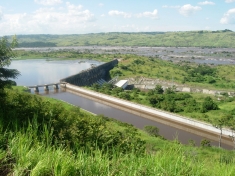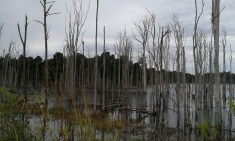State of the World’s Rivers
Toward Understanding Thresholds for Global “River Change”
- A similar version of this article was published in the International Rivers 2013 Annual Report.
The recent boom in large dam construction throughout the Global South has significantly altered rivers around the world. Despite the impact of these changes on entire ecosystems and communities, there is no oversight body that holds nations accountable for the state of their rivers. International Rivers’ State of the World’s Rivers project is an interactive online tool that aims to make fully visible the health of major river basins around the world.
At International Rivers, our research and advocacy for river protection take place on regional levels throughout the Global South. Yet, as the only global advocacy group 100% dedicated to rivers and the people dependent upon them, we also have a responsibility to build upon our nearly 30 years of expertise to understand and diagnose trends in river health on a planetary scale.
The State of the World’s Rivers project does just that. Our online, data-driven, interactive atlas offers comparative analysis of river health indicators for the world’s 50 largest river basins.

The project began with a deepening concern that the cumulative and planetary-scale consequences of converting living rivers into electricity plants and wastewater discharge zones are reaching a tipping point. Prompted by a growing “dam rush” on key rivers worldwide, this new research project asks the questions: What is the state of the world’s rivers today? What might be the state of the world’s rivers a generation from now?
The project also begins to define the terms by which the ecological integrity of rivers – and planetary processes that rivers propel, could be understood. We believe it’s a critically important question to understand how much “river change” the planet – and societies – can absorb before ecological thresholds are crossed, and before waterways cease functioning as living rivers.
Large dams – individually and collectively – change rivers like no other human intervention. The trends in large dam construction are alarming. Already, more than 50,000 large dams have impaired two-thirds of the world’s rivers. If the collective ambitions of the hydropower industry and government energy planners in many parts of the Global South are realized, hydroelectric generation will double by 2050 – which will require 9,000 new large dams. Practically no river basins on Earth would be spared from hydrological disruption.

These energy questions are interlinked with the broader debate on the most effective approaches and solutions to mitigating and adapting to a changing climate. While the grave challenge of reducing the rate of increased carbon concentrations in our atmosphere is an appropriately paramount concern for humanity, too little attention is being given to understanding the thresholds for maintaining river health. This holds especially true given that so many consequences of climate change are water-based – floods, droughts, changing ocean currents and chemistry, and so on. Maintaining viable, functioning rivers – and all the incalculable services they provide – ought to be a paramount strategy for adapting societies and ecosystems to the changes brought on by higher levels of carbon in our atmosphere.
Yet, there’s no United Nations body, no inter-governmental panel, no set of accords or river health indicators to compel nations to report on the state of the world’s rivers. In our investigation, the body of data on river health indicators varies greatly across river basins and nations, and such data is often borne out of site-specific environmental impact statements for particular large dam projects.
There are, of course, brilliant and committed academics who have devoted their careers to grappling with these questions, and their work became the basis for this initial phase of our State of the World’s Rivers report.
Some facts about planetary “river change” we’ve known for years:
- At any given time, the world’s built reservoirs contain three times more water than that which flows in rivers. Scientists have concluded that the cumulative weight of reservoirs on earth’s surface has tilted the axis of the planet.
- An estimated 40 cubic kilometers of sediment – a volume greater than Lake Mead, the giant reservoir behind Hoover Dam – is trapped each year behind dams, which starves deltas of nutrients and sediment replenishment.
- Infamously, rivers such as the Colorado, Indus and Yellow are so dammed and diverted that they seldom flow into the sea – unarguably altering the physical, chemical and biological processes of coastal marine ecosystems.
We chose indicators that emphasized ecological processes and function – such as river fragmentation, dam density and river connectivity. We selected a narrow range of water quality parameters, a decision largely driven by availability of data. We also selected biodiversity parameters such as species richness and rates of biodiversity decline. The State of the World’s Rivers online platform provides the user with an opportunity to view data spatially, see rankings and comparisons for indicators across the 50 basins, and view a sampling of river basins in focus.
Using the project’s synthesized data, International Rivers drew key conclusions and recommendations.
We recommend the following measures be taken to protect the world’s rivers:
- The evidence of planetary-scale impacts from river change is strong enough to warrant a major international focus on understanding the thresholds for “river change” in the world’s major basins, and for the planet as a whole system. An appropriately resourced inter-governmental panel should be convened to assess the state of the world’s rivers and develop metrics and thresholds regarding river health and the impacts of changes to river systems on key life processes on Earth and human societies.
- Damming rivers should become an option of last resort for managing water and generating electricity. Governments and other actors should adopt state-of-the-art River Basin Planning and Integrated Resource Planning processes and follow the highest social and environmental standards for their water and energy sector projects.
- No more dams should be built on the mainstems of rivers, which play a crucial role for the sustainability of freshwater ecosystems.
- Local communities have been the guardians of freshwater ecosystems for generations. Their voices should be heard and respected in the protection and management of rivers. River basin projects need to be based on demonstrable public acceptance, including the free, prior and informed consent of indigenous people for projects that impact their lands.
We hope this tool generates a level of interest and support to advance the project into future phases. We invite you not only to visit the online platform and engage with the data there, but to put our tools to use through collective action.
River change is real. Large dam building is accelerating the rate of change. These changes have a wide range of consequences. Understanding the scope and degree of these consequences for our living rivers – and the planetary processes they drive – is a concern of equal urgency to that of a carbon-heavy atmosphere. Join International Rivers to elevate the river crisis into the global discourse on human progress and ecological sustainability.



